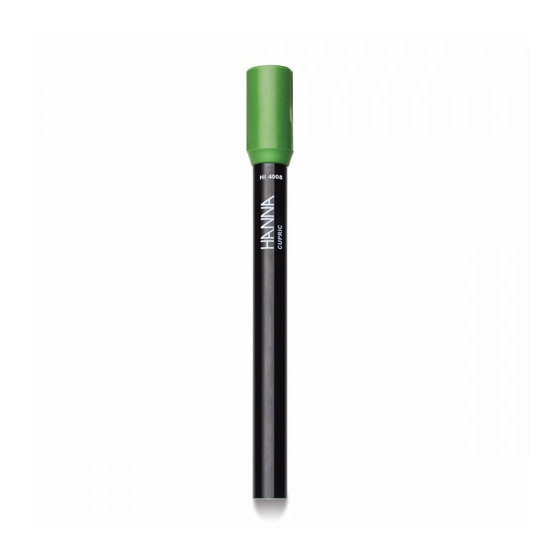
Summary of Contents for Hanna Instruments HI 4008
- Page 1 HI 4008 Instruction Manual HI 4008 HI 4008 HI 4008 HI 4008 HI 4008 Half-cell HI 4108 HI 4108 HI 4108 HI 4108 HI 4108 Combination Cupric Ion Selective Electrode...
- Page 2 HI 4008 Cupric Half-cell HI 4008 Cupric Half-cell HI 4008 Cupric Half-cell HI 4008 Cupric Half-cell HI 4008 Cupric Half-cell HI 4108 Cupric Combination Electrode HI 4108 Cupric Combination Electrode HI 4108 Cupric Combination Electrode HI 4108 Cupric Combination Electrode HI 4108 Cupric Combination Electrode I.
- Page 3 III. III. III. III. III. Theory of Operation Theory of Operation Theory of Operation Theory of Operation Theory of Operation: : : : : The HI 4108 or HI 4108 cupric electrodes are potentiometric devices used for the rapid determination of free cupric ions in samples and as a detector for the titration of cupric with EDTA.
- Page 4 IV. IV. IV. IV. IV. Design elements of the HI 4008 and HI 4108 Design elements of the HI 4008 and HI 4108 Design elements of the HI 4008 and HI 4108 Design elements of the HI 4008 and HI 4108 Design elements of the HI 4008 and HI 4108 electrodes electrodes...
- Page 5 V. V. V. V. V. Equipment required: Equipment required: Equipment required: Equipment required: Equipment required: Hanna HI 5315 Double Junction Reference Electrode with HI 7072 Fill Solution for use with HI 4008 half- cell. Hanna HI 4222 pH/ISE/mV meter or other suitable ion or pH/mV meter.
- Page 6 VII VII VII VII VII. General Guidelines General Guidelines General Guidelines General Guidelines General Guidelines Concentrated samples (>0.10 M) should be diluted before measurement. Multiply the final result by the corresponding dilution factor. Calibration standards and sample solutions should have the same ionic strength. For high ionic strength samples use standard addi- tion or titration methods.
- Page 7 Gas bubbles may form from solution out-gassing due to temperature change. Gently tap body of sensor to dislodge them from sensing membrane. HI 4008 Remove protective cover from sensor tip. HI 4108 Remove the protective plastic wrap that covers the ceramic junction before assembling sensor for the first time.
- Page 8 VIII. VIII. Electrode Preparation VIII. Electrode Preparation Electrode Preparation Electrode Preparation VIII. VIII. Electrode Preparation HI 4008 1. Remove protective cover from sensor tip. 2. Prepare reference electrode by filling outer electrolyte reservoir with HI 7072. 3. Place sensor and reference electrodes into electrode holder and connect cable connectors to meter.
- Page 9 6. Holding the body of the electrode gently press upper cap with your thumb. This permits the fill solution to drain out of the body. Release cap and verify elec- trode returns to its original position. (You may need to gently assist for this to occur).
- Page 10 IX. IX. IX. IX. IX. Quick Check of Electrode Slope Quick Check of Electrode Slope Quick Check of Electrode Slope Quick Check of Electrode Slope Quick Check of Electrode Slope Connect sensors to pH/mV/ISE meter Place meter in mV mode. Place 100 mL of deionized water into a beaker with stir bar and 2 mL of HI 4000-00 ISA.
- Page 11 and continue polishing. If the membrane is damaged, the response becomes extremely sluggish, or the slope of the electrode has decreased significantly, and procedures above have not helped, the sensor should be replaced. XI. XI. XI. XI. XI. Direct Calibration and Measurement Direct Calibration and Measurement Direct Calibration and Measurement Direct Calibration and Measurement...
- Page 12 Procedure 1) Follow sections VIII and IX to prepare sensors for measurement. 2) Follow section VI to prepare standards / solution. Standards should bracket and fall within the range of interest. Two mL HI 4000-00 ISA is added to 100 mL of both samples and standards.
- Page 13 This technique is called Known Addition. The method can use an ideal sensor slope, but actual determined slopes at the temperature of measurement should be used if known. The volume and concentration of the added standard must cause a mV change of at least 8 mV. This method is preprogrammed in the Hanna HI 4222 pH/ISE/mV meter, which simplifies the method greatly.
- Page 14 the free ions from the measurement pool. + EDTA <—>Cu-EDTA The EDTA reacts with the cupric ion forming a complex. The EDTA also can react with a host of other metals. Working at a pH between 4 and 6 optimizes the pH of the Cu-EDTA complex, and also discourages complexing with other ions that form stable complexes at high pH.
- Page 15 XIII. XIII. XIII.pH pH pH pH pH XIII. XIII. HI 4108 and HI 4008 electrodes may be used in solutions with pH values between 4 and 6. Samples above pH 6 may form Cu(OH) . Adjust these samples with nitric acid. XIV.
-
Page 16: Warranty
Damage due to accidents, misuse, misapplication, tampering or lack of prescribed maintenance is not covered. Hanna Instruments reserves the right to modify the design, construction or appearance of its products without advance notice.
















Need help?
Do you have a question about the HI 4008 and is the answer not in the manual?
Questions and answers